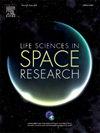模拟微重力激活大鼠视网膜自噬表达
IF 2.8
3区 生物学
Q2 ASTRONOMY & ASTROPHYSICS
引用次数: 0
摘要
目的探讨微重力下大鼠视网膜细胞自噬的表达及其可能的作用。方法将成年SD大鼠随机分为悬尾组(TS)和对照组(CTRL)。为了模拟在太空中观察到的微重力诱导的头液再分配,TS组大鼠进行了为期4周的尾部悬吊。应用光学相干断层血管造影(OCTA)评估眼血流量和视网膜厚度。采用苏木精和伊红(H&;E)染色以及透射电镜(TEM)观察视网膜的形态学变化和自噬体。采用免疫荧光法(IFA)检测大鼠视网膜内质网自噬(ER-phagy)相关蛋白(ATF4、CHOP、GRP78)。Western blot (WB)检测自噬相关蛋白Beclin1、P62、LC3B、ATF4、CHOP、GRP78的表达水平。采用实时定量PCR (real-time quantitative PCR, qPCR)检测ATG5和ATG7基因的表达。结果在眼底影像学征象中,微重力使视网膜厚度增大,视网膜血管灌注面积增大。此外,微重力还上调Beclin1、LC3B、ATF4、CHOP和GRP78,下调视网膜中的P62。它增加自噬体的数量,激活视网膜自噬和er -吞噬信号通路。结论模拟微重力可以触发机体的内在保护机制,诱导视网膜自噬(ER-phagy)的激活,这可能是一种针对微重力相关应激源不利条件的自我防御机制。本文章由计算机程序翻译,如有差异,请以英文原文为准。
Simulated microgravity activates autophagy expression in the rat retina
Objective
This study aims to investigate the expression and possible role of autophagy in the retina of rats under microgravity.
Methods
Adult Sprague-Dawley (SD) rats were randomly allocated to either the tail suspension group (TS) or the control group (CTRL). To simulate microgravity-induced redistribution of cephalad fluid observed in space, the rats in the TS group underwent tail suspension for a duration of 4 weeks. Optical coherence tomography angiography (OCTA) was applied to assess the ocular blood flow and thickness of the retina. Hematoxylin and eosin (H&E) staining, along with transmission electron microscopy (TEM), were used to investigate morphological changes and autophagosomes in the retina. Endoplasmic reticulum autophagy (ER-phagy) related proteins (ATF4, CHOP, and GRP78) in the rat retina were detected using an immunofluorescence assay (IFA). The levels of autophagy-related proteins (Beclin1, P62, LC3B, ATF4, CHOP, and GRP78) were quantified by Western blot (WB). The expression of ATG5 and ATG7 genes was examined via real-time quantitative PCR (qPCR).
Results
In fundus imaging signs, microgravity increases retinal thickness and the retinal vascular perfusion area. Moreover, microgravity also upregulates Beclin1, LC3B, ATF4, CHOP, and GRP78 while downregulating P62 in retina. It elevates the number of autophagosomes and activates autophagy and ER-phagy signaling pathways in retina.
Conclusion
Simulated microgravity can trigger the organism's intrinsic protective mechanisms, inducing the activation of autophagy (ER-phagy) in the retina, which may represent a self-defense mechanism against adverse conditions of microgravity-related stressors.
求助全文
通过发布文献求助,成功后即可免费获取论文全文。
去求助
来源期刊

Life Sciences in Space Research
Agricultural and Biological Sciences-Agricultural and Biological Sciences (miscellaneous)
CiteScore
5.30
自引率
8.00%
发文量
69
期刊介绍:
Life Sciences in Space Research publishes high quality original research and review articles in areas previously covered by the Life Sciences section of COSPAR''s other society journal Advances in Space Research.
Life Sciences in Space Research features an editorial team of top scientists in the space radiation field and guarantees a fast turnaround time from submission to editorial decision.
 求助内容:
求助内容: 应助结果提醒方式:
应助结果提醒方式:


